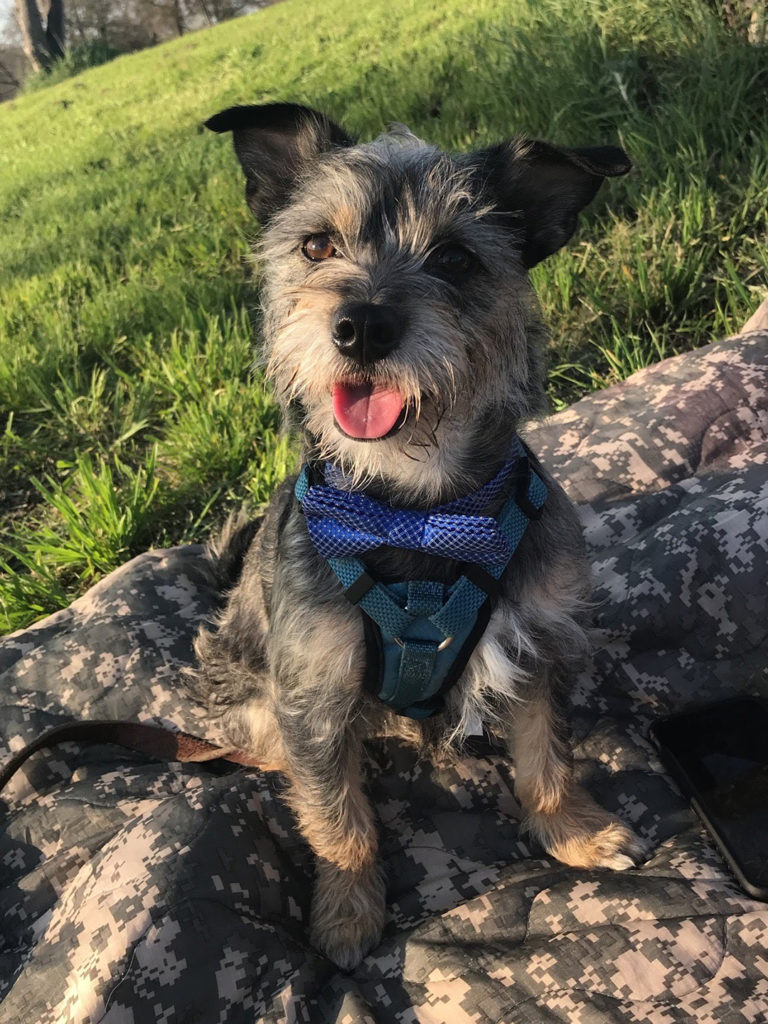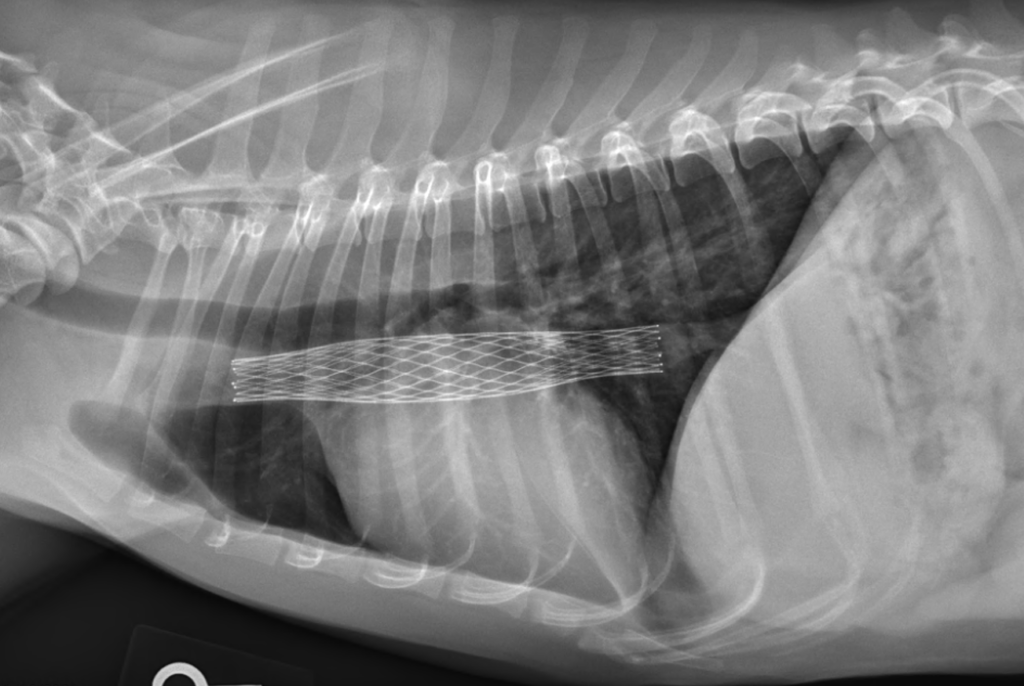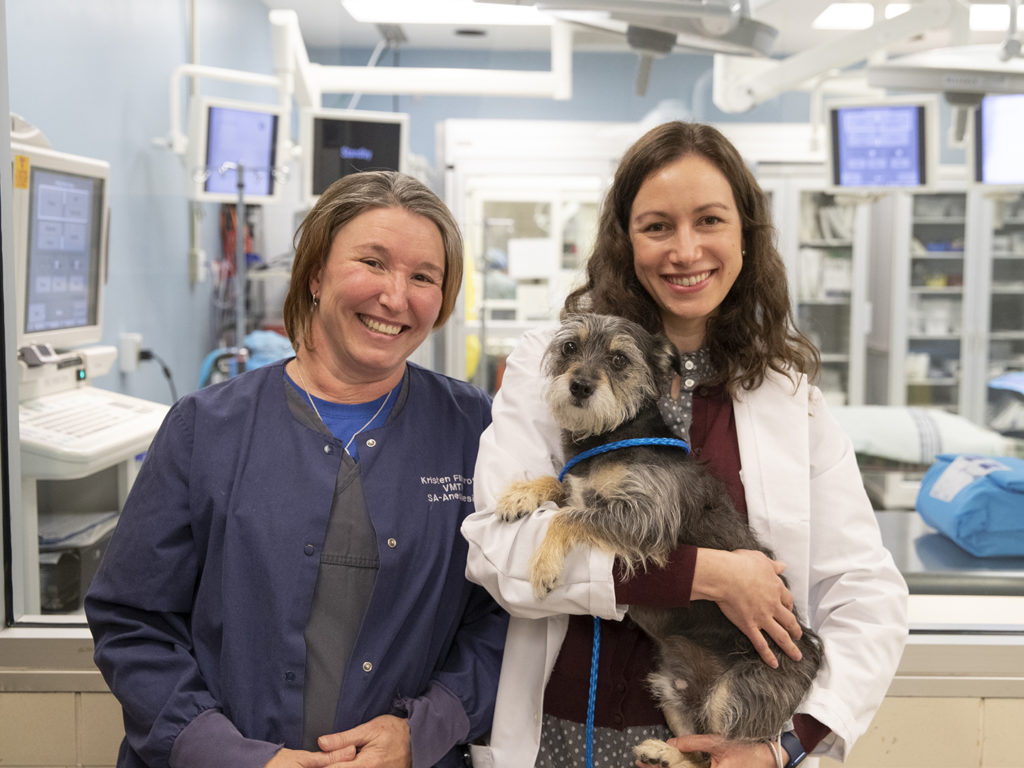Texas A&M SATH Services Collaborate To Save Dog With Mysterious Condition
Story by Megan Myers, CVMBS Communications

When Henry arrived at the Texas A&M College of Veterinary Medicine & Biomedical Sciences’ (CVMBS) Small Animal Teaching Hospital (SATH) with a mysterious condition his local veterinarians and specialists couldn’t solve, the hospital’s new Interventional Radiology Service came to the rescue with a diagnosis and treatment that saved the 7-year-old Schnauzer mix’s life.
Henry has lived with owner Jordan Johnson and her family since he was found wandering the streets of Houston following Hurricane Harvey in 2017.
“Within two days of fostering him, we knew we wanted to keep him and that he was meant to be with our family,” Johnson said. “He’s just so sweet and a great dog; he’s very loving and cuddly. Sometimes I joke that we should’ve named him Shadow, because he’s black and is like our little shadow, following us everywhere.”
Henry was a healthy and happy dog for about four years, but in April 2021, Johnson noticed a strange swelling in his abdomen.
“From April to October, we kept trying to figure out what was going on with his bloated belly, running all of these tests, but we could not find out what was wrong,” she said. “I’ve never quite been through something like that. I felt like I was watching him die and feeling so powerless. He kept losing weight, and we kept trying everything and striking out.”
Having already seen multiple veterinarians, including an internal medicine specialist in Austin, Johnson knew that Henry’s referral to Texas A&M was most likely his last chance to find out what was wrong.
A Team Effort
At the SATH, Henry’s care team used every tool at its disposal to discover the cause of the fluid collecting in his abdomen, a condition known as ascites.
The hospital’s new Interventional Radiology Service, established early last year, had the perfect team of problem-solving veterinary specialists, including CVMBS clinical assistant professor Dr. Genna Atiee and second-year internal medicine residents Drs. Jeremy Evans and Michael Hung.
“When I met Henry, I fell in love with him. He is such a cute dog and I felt so sorry for his owner, who was clearly very dedicated,” Atiee said. “His case felt like a roller coaster—highs and lows throughout.”
After even more tests that failed to discover the problem, the team connected with veterinary cardiologists Drs. Ashley Saunders and Sonya Wesselowski to take a more detailed look at Henry’s heart and vessels in the hospital’s Catheterization Lab.
Saunders and Wesselowski performed an angiogram, a procedure that uses an injected contrast dye to show how blood is flowing through the arteries and veins.

“It’s like X-ray, but in real time,” Saunders said. “When you press a pedal, you can see what you’re doing in the heart because the catheters and contrast are radiopaque (visible in a radiographic image like an X-ray).”
They discovered that Henry’s inferior/caudal vena cava, the large vein that carries blood from the legs and abdominal cavity into the heart, was compressed, causing fluid to collect in his abdomen. The vein was so narrow that blood could barely get through; as a result, blood was also building up in Henry’s liver and other abdominal organs.
Although the team was not sure what had caused the vein compression, they knew that relieving it was vital for Henry’s survival. In the months since his ascites began, he had lost a lot of muscle mass and was getting worse every day.
After discussing Henry’s condition with his owner and taking time to carefully determine the best treatment option, they decided to try using a metal stent spanning from the superior/cranial vena cava, through the heart, and out with the inferior vena cava to widen the vein and improve blood flow.
“We decided to go forward with the procedure because we couldn’t imagine not having Henry and not doing everything we possibly could to save him,” Johnson said. “It was a little nerve-wracking not knowing if it was going to work or how much time it was going to give him.”
While much of the procedure could be planned in advance, some decisions would have to wait until the operation was in progress, a risky but necessary aspect of working in such a small, delicate area.
“His was a complex case because of the location of his problem,” Saunders said. “You don’t know about pressures and flow until you get in there, so we used catheters to deliver contrast and check pressures and measurements; we then made decisions about the best thing to do based on the information we had.”
Thanks to the team of veterinarians, veterinary technicians, and anesthesiologists who gathered for Henry’s procedure, the stent was successfully deployed and soon began to relieve the ascites.
“I was really proud of the team who was in the catheterization lab making intra-operation decisions,” Atiee said. “It was a very challenging procedure but everyone was really collegial. We truly worked as a team with the common goal of helping this dog.”
A Full Recovery

Now, several months later, Henry is active and healthy, with no signs of the ascites returning.
“We’re so grateful that he is his normal self—eating, running around, and not showing any symptoms of discomfort,” Johnson said. “He’s happy and just acting like a normal dog, with no limitations from his procedure. It’s a huge relief, like an emotional weight off my chest.
“We’re also grateful for the dedication of such a great team at A&M,” she said. “They were really dedicated to doing the best they could and utilized so many different team members and doctors to figure out what was going on. We couldn’t have asked for a better outcome.”
Those at Texas A&M agree that Henry’s case perfectly represents how important collaboration is in handling challenging cases.
“After I spoke with his owner after the procedure, I felt beyond relieved—exuberant, in fact,” Atiee said. “I took a moment to recognize how thankful I was to be part of such an amazing team, to have had the opportunity to work with such a cool dog, to have worked with his owner who trusted us and allowed us to do this despite no guarantees, and to know that Henry was thriving. It was a really great moment.”
###
For more information about the Texas A&M College of Veterinary Medicine & Biomedical Sciences, please visit our website at vetmed.tamu.edu or join us on Facebook, Instagram, and Twitter.
Contact Information: Jennifer Gauntt, Director of VMBS Communications, Texas A&M College of Veterinary Medicine & Biomedical Sciences, jgauntt@cvm.tamu.edu, 979-862-4216


